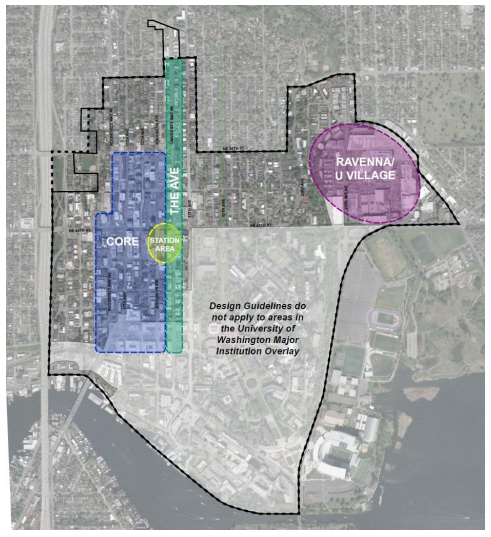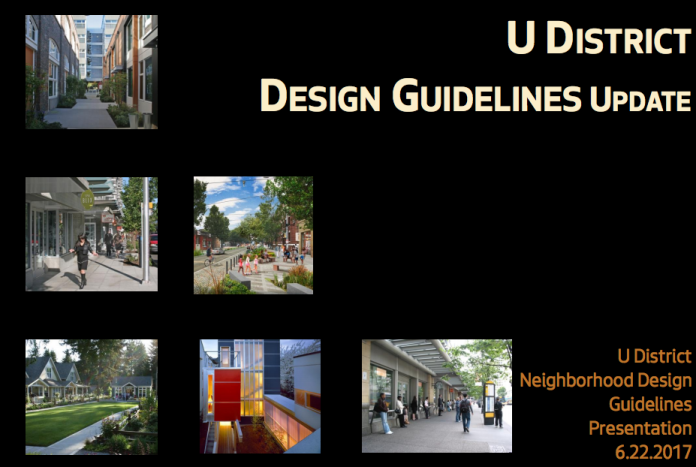The University District is a neighborhood experiencing fast-paced change as new development takes shape in the heat of Seattle’s historic building boom. A significant portion of the neighborhood recently received major zoning and land use changes that will facilitate thousands of additional residents and employees over the next few decades. Those changes came out of a neighborhood-wide planning process that still is ongoing. One piece of that process includes taking another a look at neighborhood design guidelines. Other initiatives to respond to commercial affordability and delivering public space improvements are also continuing.
Later this year, rezones and urban design regulations are slated to be adopted for University Way NE, aka The Ave, a long north-south avenue that forms an active heart to the neighborhood, as well as modest zoning changes elsewhere in the neighborhood as part of the city-wide rezoning process to unlock Mandatory Housing Affordability requirements in new commercial and residential development.
This past Thursday, the Office of Planning and Community Development (OPCD) held an evening open house to provide a background the neighborhood design guideline update process. Planners noted that the update would be the first major revision of University District design guidelines since 2000–the last update in 2013 largely dealt with formatting instead of substantive design policy. Since that time, the neighborhood has gotten its first phase of zoning changes and adopted a Green Streets Concept Plan and parks plan update.
Design guidelines for the neighborhood are layered with the first level being the city-wide design guidelines for new development. The second level is the University District design guidelines, which concerns itself with a variety of topics for consideration in new development, such as:
- Site features;
- Urban pattern and form;
- Architectural and character context;
- Open space connectivity;
- Walkability and street-level interactions; and
- Design concept in terms of uses and programming, architecture, open space, and exterior elements and finishes.
The design guidelines don’t apply to all development, but they broadly apply throughout the bulk of the University Community Urban Center.

Updated design guidelines will focus on revising substantive guidance policy as well as updating maps and graphics. In terms of the scope of guidance policy changes, OPCD is considering revisions to guidance on:
- Architectural design;
- Building form and materials;
- Public realm design and response; and
- Special site features.
The rezone changes have precipitated a particular need to change guidance discussion on height, bulk, and scale since custom zoning (Seattle Mixed-University District or otherwise known as SM-U) has been added to the neighborhood. Urban design changes related to the overall planning framework have resulted in policy changes for open space, green streets, gateways, connections, and character corridors necessitating a need to revise those throughout the document. Visual media and maps also need an overhaul to match the cascading set of policy changes.
In the course of two previous meetings, OPCD heard wide-ranging priorities from the public and stakeholders. The first meeting in April dealt with designing the neighborhood core while the second centered on public realm issues. At last week’s open house, staff summarized the feedback:
Designing in the Core
Gateways and Prominent Corners
– Opportunity sites for art, wayfinding signage, special building features
– Buildings should set back from prominent corners to create usable open space and accommodate high volumes of pedestrian traffic
– Retain Gateways designated in the existing D.G.Mixed Use Corridors
– Stoops and courtyard spaces when ground floor use is residential
– Smaller business frontage widths for ground floor retail uses with multiple entrances
– NE 42nd is an important corridor to reference in the D.G.Massing & Design of Highrise
– Building Typologies
– Unique treatment of tops of towers to enhance skyline
– Unique tower design to serve as neighborhood landmarks and wayfinding aides
– Modulation should be purposeful–not just applied, but related to building uses
Public Realm
Mid Block Connections and Alleys Eyes on the Alley
– Create safe connections
– Wayfinding is important–both signage and pavement treatments
– Amenities–seating, landscaping, pedestrian-scale lighting Streetscape and Façade Design Strategic
– Use of setback areas for buildings located on mixed use corridors to create usable public spaces
– Building frontage treatment should respond to transit stops with adequate waiting areas, leaning rails, overhangs, etc. Open Space and Amenity Areas
– Complementary design in buildings fronting on an open space area
– Amenities that consider all ages of users–for example, play spaces for children
– Encourage plazas and open space areas at corners
– Open space areas should be designed with uses in mind–not just “leftover” spaces
Next Steps
Next month, OPCD and the University District Partnership will hold a workshop dedicated to special focus areas, such as The Ave, Core, and Ravenna/U Villages. In September, planners hope to have a draft of the updated design guidelines ready for public review before holding an open house on them and finalizing the proposal. OPCD anticipates sending a final proposal to the City Council in the fall for adoption.
Stephen is a professional urban planner in Puget Sound with a passion for sustainable, livable, and diverse cities. He is especially interested in how policies, regulations, and programs can promote positive outcomes for communities. With stints in great cities like Bellingham and Cork, Stephen currently lives in Seattle. He primarily covers land use and transportation issues and has been with The Urbanist since 2014.



